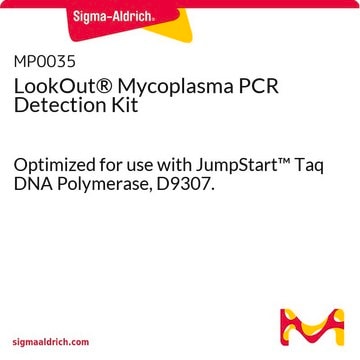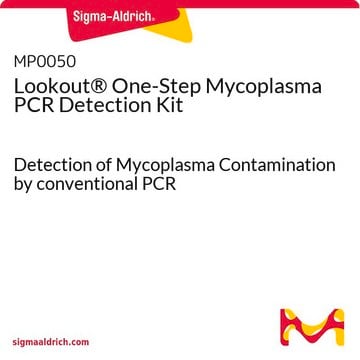11663925910
Roche
Mycoplasma PCR ELISA
Iniciar sesiónpara Ver la Fijación de precios por contrato y de la organización
About This Item
Código UNSPSC:
12352200
Productos recomendados
uso
sufficient for 96 reactions
fabricante / nombre comercial
Roche
Condiciones de envío
dry ice
temp. de almacenamiento
−20°C
Especificidad
The Mycoplasma PCR ELISA is known to detect all of the following mycoplasma, acholeplasma, and ureaplasma species: M. orale, M. arginini, M. fermentans, M. hyorhinis, M. salivarium, M. gallisepticum, M. hominis, M. bovis, M. californicum, M. bovoculi, M. Pg50 bovine group, M. bovigenitalium, M. hyopneumoniae, A. laidlawii, U. urealyticum. DNA from other bacteria (except for Clostridium sp.), yeast, and eukaryotic cells are not detected.
Aplicación
For research use only. Not for use in diagnostic procedures.
Mycoplasma PCR ELISA kit has been used for the detection of contamination by mycoplasma/acholeplasma/ureaplasma in cell cultures or other sample materials.
Mycoplasma PCR ELISA kit has been used for the detection of contamination by mycoplasma/acholeplasma/ureaplasma in cell cultures or other sample materials.
Mycoplasma PCR ELISA has been used to test mycoplasma contamination in cell lines.
Características y beneficios
Assay time: approximately 6 hours
Sample material: Cell culture supernatants, cell suspensions, or other samples
Sensitivity: At least 1 x 103 colony-forming units (cfu) of mycoplasma per milliliter of culture medium
Sample material: Cell culture supernatants, cell suspensions, or other samples
Sensitivity: At least 1 x 103 colony-forming units (cfu) of mycoplasma per milliliter of culture medium
- High sensitivity: Detects 1 - 10fg of DNA, corresponding to approximately 1 - 20 gene copies per reaction (at least 103cfu/ml)
- Broad detection range: All mycoplasma, acholeplasma, and ureaplasma species tested thus far were detected
- Simplicity: Detects all mycoplasma using the same protocol, as opposed to the culture method that requires different culture conditions for different mycoplasma species
- Fast results: The entire procedure can be performed in one day
- Easy handling of large numbers of samples: The ready-to-use mix and ELISA detection procedure allow fast and semi-automatic sample processing
Envase
1 kit containing 14 components.
Secuencia
Chain Length Positive control: 520 bp.
Otras notas
For life science research only. Not for use in diagnostic procedures.
Solo componentes del kit
Referencia del producto
Descripción
- Lysis Reagent
- Neutralization Reagent
- PCR Mix ready-to-use
- Denaturation Reagent
- Hybridization Buffer
- Biotinylated Capture Probe
- Washing Buffer 10x concentrated
- Anti-Digoxigenin-POD antibody
- Conjugate Dilution Buffer
- TMB Substrate Solution
- Stop Reagent
- Positive Control DNA
- Streptavidin-coated Microplate
- Adhesive Plate Cover Foils
Ver todo (14)
Palabra de señalización
Warning
Frases de peligro
Consejos de prudencia
Clasificaciones de peligro
Eye Irrit. 2 - Skin Irrit. 2 - Skin Sens. 1
Código de clase de almacenamiento
12 - Non Combustible Liquids
Clase de riesgo para el agua (WGK)
WGK 2
Punto de inflamabilidad (°F)
does not flash
Punto de inflamabilidad (°C)
does not flash
Elija entre una de las versiones más recientes:
¿Ya tiene este producto?
Encuentre la documentación para los productos que ha comprado recientemente en la Biblioteca de documentos.
Los clientes también vieron
Melanocytes Affect Nodal Expression and Signaling in Melanoma Cells: A Lesson from Pediatric Large Congenital Melanocytic Nevi
Margaryan N V, et al.
International Journal of Molecular Sciences, 17(3), 418-418 (2016)
Pengfei Wang et al.
Nature, 593(7857), 130-135 (2021-03-09)
The COVID-19 pandemic has had widespread effects across the globe, and its causative agent, SARS-CoV-2, continues to spread. Effective interventions need to be developed to end this pandemic. Single and combination therapies with monoclonal antibodies have received emergency use authorization1-3
Novel Non-phosphorylated Serine 9/21 GSK3?/a Antibodies: Expanding the Tools for Studying GSK3 Regulation
Tessa G, et al.
Frontiers in Molecular Neuroscience (2016)
Novel Non-phosphorylated Serine 9/21 GSK3?/? Antibodies: Expanding the Tools for Studying GSK3 Regulation
Grabinski T, et al.
Frontiers in Molecular Neuroscience, 9, 123-123 (2016)
Tessa Grabinski et al.
Frontiers in molecular neuroscience, 9, 123-123 (2016-12-03)
Glycogen synthase kinase 3 (GSK3) β and α are serine/threonine kinases involved in many biological processes. A primary mechanism of GSK3 activity regulation is phosphorylation of N-terminal serine (S) residues (S9 in GSK3β, S21 in GSK3α). Phosphorylation is inhibitory to
Protocolos
Mycoplasma contamination of cell cultures is a serious issue impacting cell model validity. PCR testing for mycoplasma is an inexpensive, sensitive, and specific method for detecting contamination.
Nuestro equipo de científicos tiene experiencia en todas las áreas de investigación: Ciencias de la vida, Ciencia de los materiales, Síntesis química, Cromatografía, Analítica y muchas otras.
Póngase en contacto con el Servicio técnico










